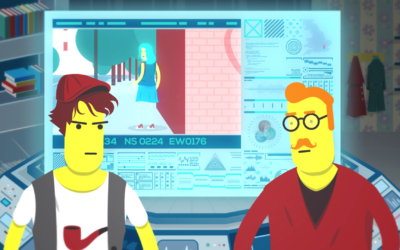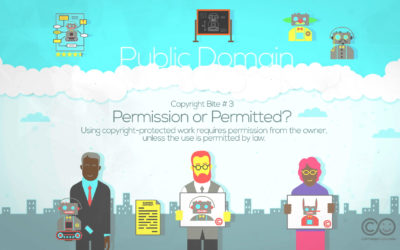Quotation, Criticism & Review
Author: Hayleigh Bosher
Illustration: Davide Bonazzi
Before October 2014, copyright law permitted use of a work for the purpose of criticism and review, but it did not allow quotation for other more general purposes. Now, however, the law allows the use of quotation more broadly. So, there are two exceptions to be aware of, one specifically for criticism and review and a more general exception for quotation. Both exceptions apply to all types of copyright material, such as books, music, films, etc.
For example, in order to critique or review a creator’s original work, the reviewer can use examples of the work to demonstrate to an audience the point they are trying to make. Similarly, extracts of copyright works can be used without permission for quotation in other contexts, such as using a short quote in a history book or an academic article.
There is a lot of overlap between the two exceptions, and both require that you meet a number of the same criteria. So, you can only rely on each of these exceptions if:
1) The purpose is really for quotation, criticism or review
2) The material used is available to the public
3) The use of the material is fair
4) Where practical, the use is accompanied by a sufficient acknowledgement
However, it is important to note that, as well as the four criteria set out above, the exception for general quotation also depends on satisfying one additional requirement:
5) Your use of the quotation must extend no further than is required to achieve your purpose
For example, the illustration above shows the famous painting of Marilyn Monroe by Andy Warhol, a lead figure of the ‘pop art’ movement. To write a review or critique on the ‘pop art’ movement it might be desirable to include examples of his work. To benefit from the exception the reviewer will need to explain to the reader the meaning and context of the review. Why is it important to use his work and this particular painting? In this case it is to position Andy Warhol within the context of other artists in the ‘pop art’ movement in order to explain how his work was interpreted by the public. Such a review piece may also touch upon other pieces of art in that period in order to explain why his work stands out from the rest.
The criteria needed for using both exceptions are explained in more detail below.
1. The reason for using the material is genuinely for the purpose of quotation, criticism or review
The law allows the use of quotation from a work for criticism or review, as well as for other purposes.
When quoting a work for the purpose of criticism or review, you can review not only the merit and particulars of the work in question but also the philosophy of the work or its moral / social implications. For example, you may wish to criticise the effects of a controversial film on society or use a digital reproduction of Pablo Picasso’s Guernica on your blog to discuss the Spanish Civil War through this painting.
You can also make use of material from one work to criticise or review a different work. For example, if you want to critique a magazine on its use of celebrity photographs, you might want to use other examples of celebrity photography to illustrate your point.
However, you cannot just reproduce the material without accompanying it with genuine critique or putting it into context, by way of discussion or assessment. For example showing a whole film and simply commenting that you liked it would not be acceptable.
2. The material you are using is already available to the public
You can use any material that is available to the public. This is generally when the copyright owner has issued copies, made the whole work available electronically, rented or lent copies of the work, or if there has been a performance, exhibition, or communication of the work to the public.
You cannot use work that has only been made available confidentially, no matter how many people this confidential transmission may include. So, for example, if someone were to share private letters with 100 people, but subject to confidentiality agreements, the material in the letter is not understood as being available to the public and therefore cannot be used.
3. Your use of the material is fair
You can select specific aspects of the material to quote or to use in your criticism or review, even if these parts are not representative of the whole work. For example, if you want to review humorous portions of an otherwise serious film, you can use examples of humorous scenes even if these parts only make up a small part of the film … just like the movie trailers do.
You can use the material to make positive or negative, and even unbalanced or hostile critique, without infringing the copyright of the creator of the work (although it will be important to be aware of defamation laws which you might be infringing).
You can take as much of the material that is fair to demonstrate your criticism, review or quotation. There is no legal definition of what is fair or unfair; it is at the courts’ discretion based on the individual facts of the case and the purpose for which the material is being used (see: ‘Legal language’ below). There may even be circumstances where it is fair to use the whole of a piece of work, for example, a short poem or a photograph.
Ultimately, for your use of someone else’s material to be fair, it should not conflict with the way in which they normally exploit their work. So, when thinking about whether your use is fair, ask yourself if your use of the copyright material is or would be in commercial competition with the copyright owner.
4. Where practical, you have provided sufficient acknowledgement
You must include an acknowledgement to identify the creator of the work and the title of the material. It is the author who should be identified and not the owner of the copyright. For example, if you are referencing a song you need to include the artist and the name of the song, not the record label. If you are making use of the work online, it is not enough to just link to the original material.
However, this requirement does not always have to be observed. There is no need to include an acknowledgement if this would be impossible for reasons of practicality or otherwise, if the work has been published anonymously, or it is not possible to identify the author of an unpublished work through reasonable efforts (see orphan works).
5. Your quotation must be no more than is required to achieve your purpose
Just to reiterate, this fifth criterion only applies to the exception for general quotation, and not to the exception for criticism and review. So, you can rely on the exception for criticism and review by satisfying the first four criteria set out above, but to benefit from the general quotation exception you must also establish that the extent of your quotation is no more than is required by the specific purpose for which it is used.
The relationship between this criterion and the requirement that your use is fair (see above) is obviously an important one. In theory, while your use might be regarded as fair it might still be more than is required to meet your purpose. Put another way, while the new exception for quotation gives everyone greater freedom to quote the works of others for purposes other than criticism and review, the scope for relying on this new exception is narrower.
What amounts to ‘no more than is required’ is not defined in the legislation. As with determining whether use is fair or unfair, what amounts to a reasonable or proportionate quotation under this fifth criterion is an issue that will be resolved by the courts on a case-by-case basis.
Another important issue concerns contractual terms that try to prevent you quoting from a work whether for criticism or review, or for some other purpose. Contractual terms of this kind are ‘unenforceable’ in law. In other words, the exceptions for quotation and for criticism and review cannot be overridden by contract.
Legal language:
This is a quote taken from a legal case, where the judge explains what is fair when considering the amount of material used for criticism or review.
Hubbard v Vosper [1972] 2 Q.B. 84
Lord Denning: ‘You must consider first the number of quotations and extracts. Are they altogether too long to be fair? Then you must consider the use made of them. If they are used as a basis for comment, criticism or review, that may be fair dealing. If they are used to convey the same information as the author, for a rival purpose, that may be unfair. Next you must consider the proportions. To take long extracts and attach short comments may be unfair. However, short extracts and long comments may be fair. Other considerations may come to mind also.’
Legal references:
The law on criticism and review in the United Kingdom is found in Section 30(1) of the Copyright Designs and Patent Act 1988, which you can read here:
http://www.legislation.gov.uk/ukpga/1988/48/section/30
The law on general quotation is now found in Section 30(1ZA) of the Copyright Designs and Patents Act. The new exception was introduced by the Copyright and Rights in Performances (Quotation and Parody) Regulations 2014 which is available here:
Related
The Game is On! – Ep. 1
In a fictional land called London, Sherlock Holmes and John Watson meet a curious client: the toymaker Joseph …
Parody & Pastiche
Parody refers to a new creative work which uses an existing work for humour or mockery. Some parodies take aim at well-known artists or their work in order to make a critique.
Copyright Bite #3
Copyright Bite #3 considers how you can lawfully make use of, or borrow from, works that are still in copyright, but without having to ask for permission or make payment to the copyright owner.











